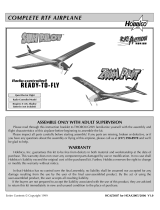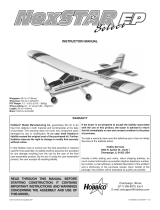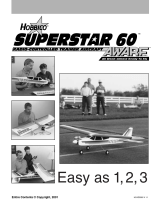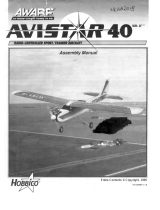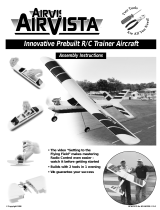Page is loading ...

ASSEMBLE ONLY WITH ADULT SUPERVISION
Please read through this instruction booklet to THOROUGHLY familiarize yourself with the assembly and flight characteristics of this
airplane before beginning to assemble the kit.
Please inspect all parts carefully before starting assembly! If any parts are missing, broken or defective, or if you have any questions
about the assembly or flying of this airplane, please call us at (217) 398-8970 and we’ll be glad to help.
WARRANTY
Hobbico
®
guarantees this kit to be free from defects in both material and workmanship at the date of purchase. This warranty does not
cover any component parts damaged by use or modification. In no case shall Hobbico’s liability exceed the original cost of the
purchased kit. Further, Hobbico reserves the right to change or modify this warranty without notice.
In that Hobbico has no control over the final assembly, no liability shall be assumed nor accepted for any damage resulting from the use
by the user of the final user-assembled product. By the act of using the user-assembled product, the user accepts all resulting liability.
If the buyers are not prepared to accept the liability associated with the use of this product, they are advised to return this kit
immediately in new and unused condition to the place of purchase.
To make a warranty claim send the defective part or item to Hobby Services at the address below:
Hobby Services
3002 N. Apollo Dr., Suite 1
Champaign IL 61822 USA
Include a letter stating your name, return shipping address, as much contact information as possible (daytime telephone number, fax
number, e-mail address), a detailed description of the problem and a photocopy of the purchase receipt. Upon receipt of the package
the problem will be evaluated as quickly as possible.
C
C
OMPLETE R
OMPLETE R
TF
TF
AIRPLANE
AIRPLANE
8 (AA) Alkaline Batteries
Electronic Speed Control
(Great Planes C-12
GPMM2015 is recommended)
3-Channel Radio
2 Micro Servos
Entire Contents © Copyright 2006 HCAZ1175 for HCAA1985 & HCAA1979 V2
™
™
Printed in China
RTF Version Requires
ARF Version Requires

Your Sky Pilot plane is not a toy, but rather a
sophisticated, working model that functions very
much like an actual airplane. Because of its realistic
performance, the model, if not assembled and
operated correctly, could possibly cause injury to
yourself and spectators or damage property.
We highly recommend that you get experienced,
knowledgeable help with assembly and during your
first flights, to make your R/C modeling experience
totally enjoyable. You’ll learn faster and avoid risking
your model before you’re truly ready to solo. Your
local hobby shop has information about flying clubs
in your area whose membership includes qualified
instructors. You can also contact the national
Academy of Model Aeronautics (AMA), which has
more than 2,500 chartered clubs across the country.
Instructor training programs and insured newcomer
training are available through any one of these clubs.
Contact the AMA at the address or toll-free phone
number below.
Academy of Model Aeronautics
5151 East Memorial Drive
Muncie, IN 47302
(800) 435-9262
Fax: (765) 741-0057
or via the Internet at: http://www.modelaircraft.org
1. Assemble the plane according to the instructions.
Do not alter or modify the model. If you make any
modifications, you will void your warranty.
2. Test the operation of the model before each flight
to insure that all equipment is operating properly,
and that the model remains structurally sound.
3. Fly only on calm days (with wind speeds less than
5 mph) and in large open areas free of trees, people,
buildings or any other obstacles.
Remember: Take your time and follow the
instructions to end up with a well-built model that is
durable and easy to fly.
The R/C model hobby becomes more and more
enjoyable as your experience grows. Your chances for
success and graduation to higher levels are very good
if you take your time and follow the assembly and
flying instructions carefully and completely. We hope
you enjoy flying your Sky Pilot plane.
Electronic Speed Control/Receiver (ESC/RX): This unit
controls the speed of the motor and the control surfaces.
Elevator: Controls the altitude.
Rudder: Controls direction.
Motor: The motor rotates the prop to provide thrust.
Nickel-Metal Hydride (NiMH) Battery:
Rechargeable batteries which are used to power the
airplane. NiMH batteries are lighter and smaller than
most other types of rechargable batteries.
Transmitter (TX): This is the hand-held unit that sends
the signal to the control unit. Moving the stick
controls the direction and climb/descent. The throttle
lever controls the motor.
GLOSSARY
PRECAUTIONS
PROTECT YOUR MODEL, YOURSELF
AND OTHERS; FOLLOW THESE
IMPORTANT SAFETY PRECAUTION
2

3
AIRFRAME PARTS AND HARDWARE
Part Name Qty.
❏ 1. Fuselage/Stabilizer ........................................1
❏ 2. Propeller ......................................................2
❏ 3. Peak Charger ................................................1
❏ 4. 1100 mAh NiMH Battery..............................1
❏ 5. Screwdriver ..................................................1
❏ 6. Wing ............................................................1
❏ 7. Rudder ..........................................................1
❏ 8. Transmitter ....................................................1
❏ 9. Mounting Screws (wing=1, struts=4) ............5
❏ 10. Instructional DVD ........................................1
❏ 11. Struts ............................................................2
Decal (Not Shown in Photo) ........................1
UNPACKING THE BOX
Check the parts against the list below.
If any parts are damaged or missing, give us a call at: (217) 398-8970.
1
2
3
4
5
6
7
8
9
10
11
FCC REQUIREMENT
Carrier Frequency: 27
This device complies with Part 15 of the FCC Rules. Operation is subject to the following two
conditions: (1) This device may not cause harmful interference, and (2) This device must accept
any interference received, including interference that may cause undesired operation.
CAUTION: Changes or modifications to this product not expressly approved by the party responsible for compliance
may void the user’s authority to operate the equipment.

❏
1. The decals for the Sky Pilot are already cut-out
on the decal sheet. Peel the decals off of the sheet
and apply them to the plane using the box as a guide
to their location.
❏
2. Insert the fin into the fin holder. Use two
medium screws to attach the fin to the holder. Be
careful to not over tighten the screws.
(If you have the Ready-to-Fly version of the Sky Pilot
with the radio system already installed, skip to
PREPARE THE TRANSMITTER, page 5.)
❏
1. Follow the manufacturer’s instructions to install the
rubber bushings and metal grommets in both servos.
❏
2. Use the screws, included with your servos, to
attach the servos to the servo tray. Note that both
servo arm output shafts are towards the front.
❏
3. Clean the back side of the receiver (not
included) with rubbing alcohol. Apply double-sided
tape (not included) to the back of the receiver. Then,
install the receiver in the fuselage, on top of the
battery holder.
❏
4. Route the antenna through the antenna tube,
located at the top back of the servo tray, and out the
tail of the fuselage. Caution: Do not cut the excess
antenna exiting out the aft end of the fuselage.
Cutting the antenna will reduce the range of the
radio system.
❏
5. Plug the right servo into the elevator servo
socket and the left servo into the rudder servo socket
of the receiver. Note: If using a 4-channel, 2-stick
transmitter, modelers that are just learning to fly will
have fewer problems if the rudder servo is plugged
into the aileron socket of the receiver. This will allow
the right stick to be used for the rudder and elevator.
RADIO INSTALLATION
(ALMOST-READY-T0-FLY VERSION)
INSTALL THE FIN
4
x 2
ACTUAL SIZE

❏
6. Your Sky Pilot requires a minimum 12 amp ESC.
Plug the electronic speed control (ESC) into the
motor connector. Plug the ESC servo lead into the
throttle socket of the receiver. Route the battery
connector from the ESC through the hole in the top
front of the battery tray. Note: If the ESC that you are
installing has an on/off switch, install it in the side of
the fuselage using the screws included with the ESC.
❏
1. The transmitter that controls your airplane
requires power, in the form of eight “AA” batteries. To
install the batteries, loosen the screw on the bottom
of the transmitter and remove the battery hatch.
❏
2. Pull the battery holder
out of the transmitter case
and install eight new “AA”
batteries, following the
diagram on the holder.
❏
3. Insert the battery holder in the transmitter case so
that the two contacts on the battery holder align with the
contacts in the transmitter case. Reinstall the battery
hatch on the transmitter case and tighten the screw.
❏
4. Switch on the transmitter and check the LED on
the front of the transmitter. If the green light is on, it
is safe to fly. If the red light is on or flashing, you need
to install fresh batteries.
❏
5. On the front of the transmitter are three switches.
The two switches on the left are for reversing the
direction of the servos. The mixing switch on the right
turns the V-tail mixing on or off. Set ch.1 switch to REV,
ch.2 to NOR and mix to OFF.
Caution:
•Do not use rechargeable (NiCd) batteries.
•Do not mix old and new batteries.
•Do not mix alkaline, standard (carbon-zinc) or
rechargeable (NiCd) batteries.
PREPARE THE TRANSMITTER
5

❏ 1. Plug the battery charger into a 12-volt power outlet
in a vehicle, placing the charger and battery outside the
car, away from flammables.
NEVER charge your airplane battery while driving or
with the vehicle engine running!
❏
2. Plug the battery pack into the charger connector.
Be careful–do not force the plugs, the battery pack will
plug in only one way. The red LED will be on solid.
❏ 3. IMPORTANT! NEVER LEAVE A CHARGING
BATTERY UNATTENDED. ONLY CHARGE THE SKY
PILOT BATTERY WITH A PEAK DETECTION CHARGER.
DO NOT USE A WIND-UP TIMER CHARGER.
❏ 4. During charging, feel the battery every 5-minutes
to see if it is starting to warm up. A warm (but not hot)
battery pack is a sign that the battery is nearing a full
charge. If the battery becomes hot, disconnect it from
the charger.
❏
5. Once the battery reaches a full charge the charger
will start to beep and the LED will flash.
❏
6. Unplug the battery pack from the charger and
unplug the charger from the 12-volt power outlet in
your vehicle.
❏
7. After each flight, remove the pack from the airplane
and allow it to cool completely before recharging.
❏
1. Always remove the battery from your Sky Pilot
before charging.
❏
2. Remember to check the temperature of the
battery every 5 minutes during the charge. If the
battery becomes hot, unplug the battery from the
charger, even if the charger has not stopped charging.
❏
3. Charging the Sky Pilot battery while your car is
running can be dangerous, because it increases the
chances of overcharging. For this reason, you should
never charge your Sky Pilot battery while your car's
engine is running.
❏
4. If you use a different peak battery charger, charge
this battery pack only at a maximum charge rate of 1
amp. A higher charge rate will charge the battery pack
too quickly and heat up the wires.
❏
5. A properly cared for battery pack will last a long
time. If the battery pack is continually charge while it
is still hot or charged at too high of a rate, the life of
the battery pack will be shortened.
WARNING: Misuse or malfunction may overheat the
battery and charger, resulting in personal injury or
damage to surroundings.
BATTERY CHARGING PRECAUTIONS
CHARGE THE PLANE’S NIMH BATTERY
6

ATTENTION: The product you have
purchased is
powered by a
rechargeable battery. At the end of
the battery’s useful life, under
various state and local laws, it may
be illegal to dispose of this battery
into the municipal waste system. Check with your
local solid waste officials for details in your area for
recycling options or proper disposal.
WARNING: This product contains a chemical known
to the State of California to cause cancer.
Check and tighten the screw in the prop adapter
before each flight. (If you have the Ready-to-Fly
version of the Sky Pilot with the radio system already
installed, skip Steps 1 and 4.
❏
1. Install the screw-lock pushrod connector in the
hole 1/4" (6.4mm) from the center of the servo arm.
Press the plastic pushrod connector keeper on the
pushrod connector pin. Install a 4-40 machine screw
in the top of the pushrod connector. Make two servo
arms with pushrod connectors attached.
❏
2. Switch on the transmitter. Make sure the green
light is on. Open the battery hatch cover on the
bottom of the plane and attach the battery to the
connector. If needed, switch on the ESC.
CAUTION: Once the battery is connected to the
ESC, stay clear of the propeller.
❏
3. Center the rudder (or aileron) and elevator trim.
❏
4. Insert the elevator and rudder pushrods through
the pushrod connectors. Install the servo arms on the
rudder and elevator servos so that both arms face the
middle and are centered. Remember to reinstall the
servo arm screws.
RADIO ADJUSTMENT
BATTERY RECYCLING
7
x 2
ACTUAL SIZE

❏
5. Install the rudder and elevator pushrods in the
outer holes of the control horns. Slide a pushrod
retainer over the pushrods to secure them.
❏
6. If you have the Ready-to-Fly version, we
recommend that you check the elevator and rudder.
With the elevator and rudder sticks and trims centered,
position the elevator in-line with the stabilizer and
tighten the screw in the elevator pushrod connector.
Position the rudder in-line with the fin and tighten the
screw in the rudder pushrod connector.
The throws are measured at the widest part of the
elevator and rudder. Adjust the position of the
pushrods at the servo arms and the control horns to
change the amount of throw. Moving the pushrod out
away from the center of the servo arm or in on the
control horn will increase the amount the control
surface moves.
❏
1. When viewing
the airplane from the
aft end, move the
rudder stick to the left.
The rudder must move
to the left. If it does
not, change the
position of the rudder
servo reversing switch
on the transmitter.
When the rudder stick
is moved all the way left, the trailing edge of the
rudder should move to the left 3/8" (9.5mm). When
the rudder stick is moved all the way right, the
trailing edge of the rudder should move to the right
3/8" (9.5mm).
❏
2. By moving the
elevator stick down, the
elevator must move up.
If it does not, change the
position of the elevator
servo reversing switch
on the transmitter. When
the elevator stick is
moved all the way down
(towards you) the
trailing edge (back edge) of the elevator should move
up 3/8" (9.5mm). When the elevator stick is moved
all the way up (away from you) the trailing edge of
the elevator should move down 3/8" (9.5mm).
CHECK THE CONTROL THROWS
8

❏
3. To start the motor, the throttle lever must first be
“OFF”, all the way to the left when switching on the
transmitter and plane. Then move the lever all the way to
the right and hold it there for 5 seconds. Then return the
lever to the left. This will “arm” the motor. The motor will
now operate when the throttle lever is moved to the
right. NOTE: Arming the motor will need to be done
each time after the transmitter has been turned OFF!
❏
1. At the front edge of the wing are two small posts.
Position the wing on the top of the fuselage and slide
the wing forward, inserting the posts in the holes on
the fuselage. Fasten the wing to the fuselage with the
large screw and metal washer. The screw should be
tight enough to hold the wing snug against the
fuselage, yet does not crush the wing.
❏
2. Turn the plane over and attach the wing struts to
the battery tray and the wing with four small screws.
Important: The Sky Pilot must never be flown without
the wing struts attached. The wing struts help support
the wing.
Note: This section is VERY important and must NOT
be omitted. A model that is not properly balanced
will be unstable and possibly unflyable.
❏
1. After the battery pack is charged, open the battery
hatch. Insert the battery pack inside the fuselage. Do not
plug the battery pack into the connector inside the
fuselage. Close the battery hatch.
CHECK THE BALANCE OF THE MODEL
INSTALL THE WING
9
x 4
ACTUAL SIZE
x 1
ACTUAL SIZE

❏
2. Place marks on the bottom of the wing 1-7/16"
(35mm) and 1-3/4" (45mm) back from the front of the
wing, next to the left and right sides of the fuselage.
Turn the airplane right side up. Try to balance the
airplane on your finger tips, between the marks. This
is where the model should balance. We also found
that most of our test models balanced at this point
out of the box without having to add weight to the
nose or tail. If it does not balance at these marks,
weight will need to be added to the nose or tail. At
most hobby shops, you can purchase stick-on lead
weight made specifically for balancing airplanes.
The Sky Pilot should be flown only when the wind
speed is 5 mph or less. If the wind is calm or very light,
the Sky Pilot will be docile and easy to control. Also,
find an area clear of trees, power lines and other
structures. A flying field for R/C planes is best. Don’t fly
around groups of people, especially children or within
6-miles of existing R/C flying fields.
1. Find an open area free of buildings, trees, power
lines and people.
2. For your first few flights, fly only when the wind is
calm. After you are comfortable with the airplane, you
can fly in winds that are no more than 5 miles per hour.
If flown in stronger winds, the plane may be blown
down wind and not have enough power to get back.
3. Make sure the battery pack is fully charged and
that the transmitter has fresh “AA” batteries installed.
4. If others are flying in the same area, make sure that
they are not using the same channel radio system you
are. The front of your transmitter has a tag with a
number on it (i.e. 1 through 6 and 26.995 through
27.255). This is the channel number and frequency
you are using. If someone is on the same channel or
frequency, DO NOT switch on your transmitter until
they are finished flying.
Your transmitter controls the altitude, direction and
speed of the airplane. The stick controls the altitude and
direction and the lever on the top of the transmitter
controls the speed.
When the battery power gets too low, the “Auto Cut-
Off” feature of the speed control provides an extra
degree of insurance. It reacts to low power by pulsing
the motor on and off, in effect saving power for the
receiver. That way your airplane goes into a glide and
you stay in control as you land.
If you have never flown an R/C airplane before, we
recommend that you get help from an experienced
R/C pilot. Most R/C clubs have training programs that
will help you learn to fly quickly. If you cannot find
an experienced pilot to help you learn, the following
will help you get your airplane into the air.
1. First switch your transmitter power switch “ON.”
This immediately puts you in control. Be sure your
throttle lever on the top of the transmitter is all the
way to the left.
FLYING THE SKY PILOT
PREPARE FOR TAKEOFF
CHOOSE A GOOD FLYING SITE
10

2. Now pick up the airplane and switch the airplane
on. Caution: Keep your hands behind the propeller.
3. Arm the motor by moving the throttle lever all the
way to the right. Hold the throttle lever here for the
count of 5. Then, move the throttle lever back to the
left. Now when the throttle lever is moved to the
right, the propeller will start to turn. The farther the
lever is moved, the faster the propeller will turn.
4. Range check your radio before each flight. Switch
on the transmitter and then switch on the airplane.
Have a helper hold the airplane. With the transmitter
antenna collapsed, walk 100 feet away from the
airplane, holding the transmitter with the antenna
pointing up. Move the control stick, checking that the
control surface responds. Also, turn the motor on and
check the range. If you still have control of the
airplane, it is safe to extend the transmitter antenna
and fly the airplane. If you do not have control of the
plane, make sure the batteries in the transmitter are
fresh and the battery in the plane is charged. Also,
make sure the wire antenna is extending out the back
of the airplane.
5. With the throttle lever moved fully to the right,
hand launch the Sky Pilot into the wind, at a slight
upward angle. Note: For the first couple of flights, we
recommend having a helper hand launch the
airplane. After you become familiar with the flight
characteristics of the airplane, it can be flown off a
hard surface instead of hand launched.
6. Pull the stick toward you so that the plane climbs
at a 20 to 30 degree angle. Allow the airplane to
climb a few seconds before turning it.
7. When your airplane is moving away from you,
moving the rudder stick to the left will make your
plane turn to the left. Moving the stick to the right
will make the airplane turn to the right. By adding a
little up elevator (moving the stick towards you)
during the turn, the airplane will turn much tighter. To
stop the turn, move the stick the opposite direction
until the airplane is flying straight. Caution: It only
requires a small amount of up elevator.
8. When the airplane is coming toward you, moving
the rudder stick left still causes left rudder, but your
airplane goes to your right. In short, you have to
reverse the way you control the rudder. Here’s a good
way to familiarize yourself with the controls: When
the airplane is coming toward you, turn your body so
that you are facing the same direction the airplane is
going, looking over your shoulder at the airplane.
Now when you move the rudder stick left, the plane
will go to your left.
9. Now that you have gained some altitude, it is time
to trim the plane for straight, level flight. If the
airplane wants to climb when the elevator stick is
released, move the elevator trim lever up away from
you. If the airplane wants to dive, move the elevator
trim lever down away from you. It should require
very little trim. Your goal is to have the airplane fly
level with the elevator stick centered.
10. Now, with the airplane flying level, check to see
if the airplane is flying straight. If it wants to turn
when the rudder stick is centered, move the rudder
trim lever opposite the direction the airplane is
turning. The airplane should be trimmed so that if
you take your hands off of the control stick, the
airplane will fly straight and level on its own. Having
the airplane trimmed properly makes flying much
easier and more enjoyable.
11. Don’t let the airplane get too far away from you.
The farther away it is, the harder it is to see what the
airplane is doing.
12. When learning to fly, it is best to keep the
airplane high enough so that if you make a mistake,
you have enough altitude to correct the mistake.
11

It’s a known fact among fellow R/C pilots that your
airplane will land. It is up to you as to where and
how it lands.
1. For your first couple of flights we recommend that
you attempt to land before the motor stops. Your Sky
Pilot comes with an auto cut-off feature which
reserves battery power for safe landings.
2. During your first flight, while at a high altitude,
turn the motor off and notice how the Sky Pilot
reacts. This will give you an idea of how the airplane
will react during a landing.
3. To land the Sky Pilot, fly down wind, past the
landing area. Gently turn into the wind and reduce
the throttle so that the airplane starts to come down.
Adjust the throttle as needed to reach the landing
area, but not past it.
4. Just before landing, at about 1 foot above the
ground, apply a little up elevator to flare (raise the
nose of the airplane). This will cause the airplane to
slow and settle to the ground.
Switch off the airplane. Then, switch the transmitter
off. Unplug the battery from the airplane and remove
the battery from the battery compartment. Allow the
motor and battery to cool before recharging. Check
the airplane over to make sure nothing has come
loose or may be damaged.
To order replacement parts for your Sky Pilot, use the
order numbers in the list below. Replacement parts
are available only as listed. Replacement parts are
not available from Product Support, but can be
purchased from hobby shops or mail order/Internet
order firms. If you need assistance locating a dealer
to purchase parts, contact:
Product Support
Phone: 217-398-0007 Fax: 217-398-7721
E-mail: [email protected]
Before starting to build, take an inventory of this kit
to make sure it is complete and inspect the parts to
make sure they are of acceptable quality. If you need
assistance with assembly, contact Product Support.
When reporting defective or missing parts, use the
part names exactly as they are written in the parts list.
Even the best R/C pilots in the world damage their
airplanes every now and then. In the unfortunate
event that you damage your airplane, repairs are
fairly simple to make yourself. If there are any cracks
in the wing or fuselage, apply 6-minute epoxy or
white glue to the broken areas and hold together with
clear packaging tape. Let the glue cure, leaving the
tape in place for added strength.
REPAIRS
Stock # Description
HCAA3518 ....Battery 8.4v,
1100mAh NiMh
HCAA3519 ....Main Wing
HCAA3520 ....Propeller (2)
w/Hub
HCAA3521 ....Cowl w/Screws
HCAA3522 ....Decals
HCAA3523 ....Struts (L & R)
HCAA3524 ....Motor Mount
HCAA3525 ....Main & Nose
Landing Gear
HCAA3526 ....Wheel Pants (3)
HCAA3527 ....Tail Assembly
Stock # Description
HCAA3528 ....Battery Hatch
Door
HCAA3529 ....Fuselage Set
w/Pushrods
HCAG3479....Motor 380
HCAM7500 ...Servo
HCAM7505 ...Servo Bearing Set
HCAM7506 ...Servo Horn
HCAM7106 ...Transmitter
Antenna
HCAP9927 ....Peak Charger
HCAQ3017....Propeller (2)
REPLACEMENT PARTS LIST
AFTER THE FLIGHT
Caution: If, during a rough landing, the propeller on
the Sky Pilot should become jammed and cannot
rotate with the throttle in the run position, the
battery and speed control will become very hot.
Immediately move the throttle lever to the left to
stop the motor. If you fail to do this, the motor, speed
control and/or battery will be damaged.
IT’S NOW TIME TO LAND
/
